When flood strikes, it can wreak havoc in two ways. First is the immediate damage from the water itself. The second is the long-lasting aftermath.
Back in December 2015, the UK experienced the wettest month it had seen on record so far. The Environment Secretary at the time, Liz Truss, told parliament that around 16,000 homes had been flooded, causing millions in recovery and repairs.
However, she also pointed out that more than 20,000 homes were protected due to flood defences that had been put into place. It just goes to show that, although you can’t prevent a flood from happening, you can help minimise the damage it causes to your home.
Jump to:
- Am I at risk of flood?
- Types of flooding for homes and businesses
- How flood risk can affect property value
- Getting insurance for a flood-risk property
- How flooding can damage your home
- How to plan for a flood
- Permanent ways to make your home flood-resilient
- Temporary flood prevention measures to protect your possessions
- How to stay safe during a flood
- How long does it take to reinstate a property?
- What to do after a flood
- Making an insurance claim
- Getting help after a flood
Am I at risk of flood?
In theory, a flood can happen wherever it rains and at any time of year.
It’s usually caused by a period of heavy rainfall (typically days), causing rivers to burst their banks and spread across the nearby land. This is made worse when the surrounding soil is unable to absorb the water. That’s why areas with rivers enclosed by steep slopes and lack of vegetation, or in a drainage basin consisting of water-resistant rock are more prone to flooding.
Coastal areas are also at risk, especially when storms bring waves onto the land.
Don’t be caught off-guard though. Cities and suburban areas can also experience flooding in extreme weather, particularly if drainage systems are insufficient. You also need to factor in rainwater running off hillsides, overflowing sewers and maintenance issues such as burst water pipes.
So, even if you don’t live close to the water, it’s worth checking to see if you live in an area that’s likely to feel the impact of a flood. Government flood maps offer risk factors based on postcodes – so they’re ideal as a general guide to see whether your area has adequate flood defences in place.
For a more accurate assessment, a specialist conveyer should be able to provide you with a detailed report regarding your specific property. This should determine its risk against the different types of flooding that might occur in your area, as well as recommendations on how to reduce or eliminate the effects.
If you’re a potential buyer, check whether there have been previous incidents of flooding to the house you want to buy. If nothing else, you’ll need to be aware of issues regarding the property’s insurability, which may influence its value and whether you can get a mortgage on it.
Common types of flooding for homes and businesses
One way to help evaluate the risks to your home or business is to understand which types of flood you’re likely to face in your area.
Sources such as the Local Goverment Association can help identify common types of flooding in the UK, highlighting how each one occurs, how it may be forecasted and the damage it can cause.
Fluvial flooding (rivers)

Fluvial floods occur when a river channel or stream can’t cope with the sheer volume of water draining into it - usually from extensive rainfall, although it can also be a result of a river blockage (such as a fallen tree or dumped rubbish).
Current river levels, previous and forecasted rainfall, and temperatures are often considered factors when measuring the probability of a fluvial flood.
It usually results in two ways:
- The water level rises, causing the river to burst its banks and flood the surrounding land. The floodwater tends to be shallow but can remain for days in flatter regions.
- In hilly or mountainous areas, heavy rainfall can occur within minutes and lead to a dangerous ‘flash flood.’ This is when the force and velocity of the water creates destruction to anything being swept up in its flow.
The damage from river floods can be widespread. It will depend on the amount of water that has fallen in your area, how long it takes to collect, the saturation of the soil and the terrain surrounding the river itself.
It’s worth noting that if you own land with a boundary next to a waterway, you have a legal duty to keep the banks clear of anything that could cause obstruction and increase flood risk.
Surge flooding (coastal)
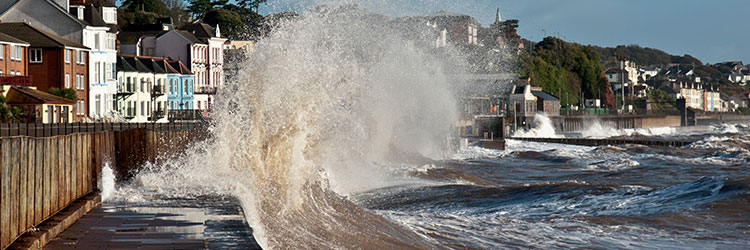
Heavy storms combined with high tides can cause sea levels to rise and result in coastal flooding.
The Environment Agency and SEPA constantly monitor sea levels and release flood warnings when required. The severity of the flood is determined by various factors such as the strength, size, speed and direction of the storm.
The landscape and density of nearby areas can also play an important role. For example, low-lying land is more likely to experience devastating damage.
Although flood defences can be put into place to protect your coastal property, wider engineering solutions are limited by the fact that huge volumes of seawater can’t be contained or channelled.
Pluvial flooding (surface water)
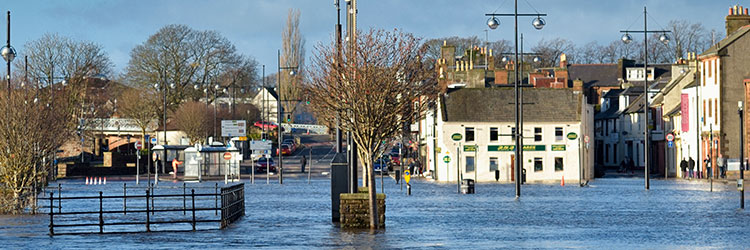
A common misconception is that a flood will only affect you if you live near a large amount of water. However, pluvial floods often happen in built-up areas, as well as places that are higher than coastal or river floodplains.
It’s caused when an area’s drainage system reaches its capacity - either a result of extreme rainfall, fast flowing water that can’t be absorbed or a maintenance issue within the system itself.
Although typically only a few centimetres deep, surface water can cause significant property damage and last for weeks or months after a flood has hit.
Pluvial floods are difficult to predict compared to the other types, yet are expected to be more frequent due to climate change and over-development in floodplains.
How flood risk can affect property value
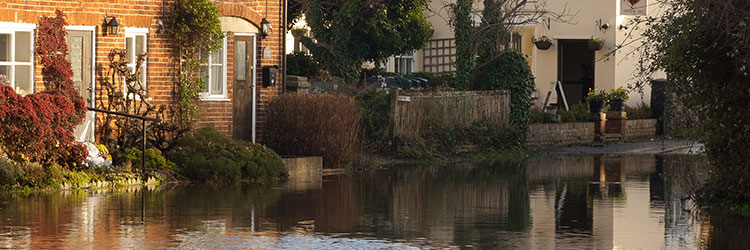
According to Royal Institution of Chartered Surveyors (RICS), over five million homes in the UK are at risk of flooding.
Although the risk could be relatively small for the majority of these homes, property value can often be lower than for houses that aren’t considered at risk at all.
This could partly be down to potential buyers and their concerns with buying a home in a flood-hit area. The possible threat to their safety and possessions, as well as clean up costs and months of disruption can easily deter them.
That said, some buyers might view flood-hit areas as a place to pick up a property bargain, willing to spend money on decent flood protection in order to make the deal worthwhile. A beautiful river or sea view could outweigh the potential risks for some.
Others might consider the cost and availability of insurance as more important. Citizens Advice suggests you'll need at least a standard insurance policy to cover the structure of the building if you're planning to buy the house with a mortgage. But a buyer might struggle to secure a mortgage on a high-risk home and, according to London's Surveyors and Valuers, is likely to suffer soaring insurance premiums as a result. This can be detrimental to the value of the property.
If you live in an area that repeatedly floods, the location circumstances, construction type and what flood defences are in place (at both the home and in the area) will all be considered.
Getting insurance for a flood-risk property

If you live in a flood-risk area, it’s sensible to have insurance that covers any damage to your home and possessions caused by water.
If you’re unsure, now is the time to review the finer details of your policy and identify exactly what you’re entitled to when it comes to flooding.
Here are some of the things to look out for:
-
How much you’re entitled to should you need to rebuild your home after severe water damage.
-
Whether it covers the cost of drying out, repairing and restoring the structure of the building.
-
Whether it includes the repair or replacement of your damaged belongings and furniture.
-
If it provides temporary accommodation should your home be uninhabitable after a flood.
-
If it covers the cost of any professional fees you may need to pay, such as solicitors and surveyors.
-
Whether it covers damage to professional equipment and stock, or even commercial disruption if you run a small business at home.
-
Whether the insurance company provides a helpline service or offers advice on how to prepare and deal with flooding.
If you’re a new homeowner or tenant currently trying to get insurance for a high-risk property, you may find some insurers turn you away if they’re under no obligation to offer flood cover.
Rather than using price comparison websites, phoning insurers directly could help increase your success rate. And whether you’re struggling to get household insurance or not, it’s well worth checking to see if you’re eligible for Flood Re.
Here are a few tips when it comes to flood insurance:
-
When getting quotes, tell the truth. Don’t be tempted to overlook any previous flooding incidents - it could invalidate your policy and you might not be able to make a claim should you need to.
-
The cheapest policy isn’t always the best. Read the policy in full to ensure it meets your needs before buying.
-
Think carefully and realistically about the value of your household items. While it’s understandable to not want to be overinsured, underinsuring possessions could result in only part of your claim being paid.
-
Keeping receipts of major items and taking photographs of your rooms (along with your contents) will be a useful reference when making a claim.
-
Remember that each insurance company takes a different approach when it comes to flood claims – there’s no harm in looking around to ensure you have the best cover.
How flooding can damage your home
It seems obvious, but one of the biggest consequences of a flood is water damage. Too much water in the wrong place not only destroys possessions, but also causes further damage if it’s left standing in your property.

The duration of the flood and the height of the water can determine how much damage it creates, but it’s not only about the physical impact on materials. Bacteria, mould and viruses from standing water can trigger allergies and lead to disease - so it’s also a huge health hazard.
Other problems include:
-
Structural damage
-
Electrical risks
-
Gas and heating systems
-
Foundation damage
-
Personal possessions ruined
-
Drainage and sewage systems
-
Damaged crops and plants
-
Contaminated drinking water
-
Sanitary hazards
-
Disease from standing water
-
Bacteria, mould and dampness
-
Discolouration and rot
-
Humidity in the air
-
Pests attracted to rubbish
All of these issues are bad news, but perhaps the biggest consequence of having too much water in the house is foundation damage.
According to Live Science, water travelling at 10 miles per hour has the same force as wind travelling at 270 miles per hour. No wonder the impact of this moving water (both inside and underneath the home) can weaken the property structure and separate it from its foundation.
Here are some common signs to look out for:
-
Doors and windows not shutting properly.
-
Cracks in doorframes, walls, ceilings and floorboards.
-
Large tears in wallpaper.
-
Garage door no longer closes to meet the ground.
-
Bricks in your outdoor foundation have cracked.
-
Foundation outside has moved from the level of the garden.
-
Sloping floors, or gaps between walls, ceiling and floor.
Although it’s important to document the damage caused by flooding, it’s equally important to keep safe. If you’re unsure about water and foundation damage and the possibility of hidden dangers, seek a professional evaluation.
How to plan for a flood
If you live in a high-risk area of flooding, it’s vital to be prepared. Here are seven simple steps to help put together a flood plan.
1. Sign up to Floodline
This is a government website that notifies you when there’s a risk in your area.
It’s free to register online or you can call them on 0345 988 1188.
2. Know your flood warning signs
 |  |  |
| Flood alert - Prepare Be prepared. Monitor local news and weather forecasts. Be aware of water levels near you. Be prepared to act on your flood plan. Check on the safety of pets and livestock. Charge your mobile phone. | Flood warning - Act Immediate action is required. Move your family and vital items to higher ground. Put flood protection equipment in place. Turn off gas, electricity and water supplies (if it's safe to). Be prepared to evacuate your home. Act on your flood plan. | Severe flood warning – Survive Stay in a safe place. Co-operate with emergency services when evacuating. Collect only the things you need for an evacuation. Avoid electricity sources if water enters your home. Avoid walking, touching or driving through flood water. Call 999 if in direct danger. |
3. Know who to contact and where to go
-
Agree an evacuation plan with your family so you all know where to go and how to contact each other.
-
Know where your nearest evacuation centre is. Check with your council if pets are allowed in the centre.
-
Keep a checklist so you know which actions to take during a flood and have a list of all the important contacts in one place. To help you get started, you can download and print this checklist from the Environmental Agency.
4. Move your treasured items
Decide on what you want to keep safe during an emergency.
- Personal possessions?
- Sentimental items?
- Photo albums?
- Family heirlooms?
- Portable electrical equipment?
- Furniture items?
- Garden plants?
Think ahead. Is there anything that can be moved to a higher place now? Is there a neighbour or family member close by who can help you move larger items quickly? Now is the time to plan.
5. Know how to turn off your mains
It’s important to turn off your gas, electricity and water mains supply before evacuating in case floodwater enters your home.
Become familiar on how to do it and where to find the relevant taps and switches in the house. Ask your supplier or landlord if you’re unsure.
If taps or switches aren’t clearly marked, label them with stickers or symbols to help prompt you in an emergency.
6. Have an essential ‘flood kit’ handy
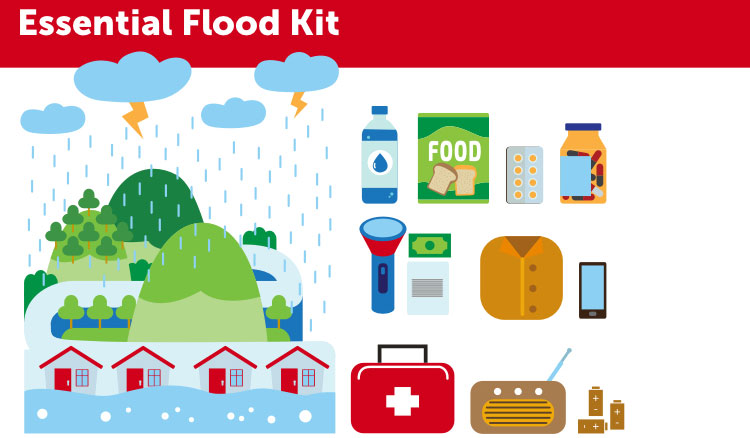
-
Insurance documents
-
Bank account details
-
Birth and marriage certificates
-
Recent tax returns
-
Passport and licences
-
Prescription medication
-
First-aid kit
-
Cash (banks or ATMs may be closed for long periods)
-
Bottled water (change every six months)
-
Non-perishable foods
-
Baby food and care items
-
Torch with spare batteries
-
Battery radio
-
Warm waterproof clothing
-
Blankets and pillows
7. Repeat for your business and community
Although the main focus should be on your personal flood plan, it’s important to create one for your business too - especially if you work or store professional equipment at home.
When you live in a high-risk area, you’re not the only one who might experience the disaster. Working with the community to help support and keep each other safe is really important. If you don’t have one already, try bringing the local residents together so you can all agree on a flood plan for the community.
Permanent ways to make your home flood-resilient
If you live in a flood-risk area, it’s sensible to have insurance that covers any damage to your home and possessions caused by water.
The main principle behind insurance is to ensure policyholders get back on their feet and in the same position they were before they made the claim.
This means policies often only repair or replace what existed before – they don’t cover the costs of improvements or general maintenance to undamaged areas.
That’s why most flood victims who make an insurance claim put their damaged house back to how it was. But this can make it a recurring battle, as the repaired home will still be at risk should another flood hit.
With this in mind, it’s essential to take on some of the responsibility in making your home or business flood-resistant. And it could be more cost-effective to do it now rather than repeatedly paying for damage repairs.
This isn’t just about sealing foundation cracks or fixing a leaky roof; it’s about making permanent changes so your home is more resilient during a flood.

-
High shelving to store ornaments and personal items.
-
Waterproof coating on walls and sideboards.
-
Rugs that can be rolled away.
-
Cover for ventilation bricks.
-
Cleared gutters and drains.
-
Tiled floors that are easier to sweep up than carpet.
-
Wall-mounted TV.
-
High-fitted power sockets.
-
Flood guards on windows and doors.
Putting up shelves and installing electrical equipment higher than the typical flood-level line means you’ll have a few less items to worry about if floodwater enters your home.
Consider having your fuel tank installed and anchored in a higher place too, preferably upstairs if possible. Unanchored tanks can move significantly and be damaged during a flood, spilling fuel and causing pollution.
If you live in a rural area and your home is heated with an oil-fired system, have your tank checked by a professional. Even if you don’t live in a flood-risk area, it’s advisable to ensure your tank and pipework is in good working condition. Consider pipe lagging, a special type of insulation fitted around water pipes to prevent them from freezing or bursting.
Flooding can sometimes cause sewage to back up into the house through drainpipes. As well as being a health hazard, this can be difficult and costly to repair. Consider installing sewer or septic line valves – they’re designed to flow the waste in one direction only, protecting your home from unwanted mess.
Lots of home improvement sites (such as Permagard) offer advice on different types of water-resilient insulation you could install in your home, such as floor-to-wall membranes that help channel water towards drains. You could also try lightweight thermal boards underneath your floors, or even PUR spray foams for an extra layer of protection in vulnerable parts of the home.
If you live on a slope, consider installing a French drainage system. This is a gravel-filled trench with a slotted pipe that collects water in your garden and diverts it safely away from the house.
Taking these permanent measures now should not only help prevent water from entering your house, it should reduce the repair costs and help you recover more quickly after a flood.
Temporary flood prevention measures to protect your possessions

When the risk of flood becomes a reality, there’s rarely time to save everything of value, which is why it’s best to take steps in advance to protect your possessions.
Flood protection equipment
Storing flood protection equipment at your home is an extremely good idea, as these can temporarily prevent water from getting inside your property.
Flood boards are usually lightweight and can create a watertight seal when fixed around windows and doorframes. They’re also reusable.
Sandbags are a good alternative. You can either buy your own or your local council may be able to provide some (although these can be scarce in a crisis).
Airbrick covers can be bought and fixed over the ventilation bricks that otherwise helps your house breathe. You can also stop water from getting through by sealing them with plastic covers.
Spare plugs and towels are handy for clogging any water inlets, especially if your pipes haven’t been fitted with non-return valves. Make sure you have plugs for all bath and sink holes, keeping extra sandbags aside so you can weigh them down.
Sump pumps are also a good investment in case you need to pump water out of the house. Just be sure it’s a battery-assisted one.
Tips for protecting your personal possessions

When it comes to valuables and treasured items, keep them locked away - preferably upstairs and in a waterproof container.
Do the same for important documents. Consider scanning and maintaining digital copies, keeping them in a waterproof safe or in a deposit box in a secure location away from the home.
Back up your computer to avoid losing personal work, sentimental material or stored family photos - flood damage could easily wipe your hard drive.
If you can do it safely, raise household appliances off ground level and onto solid bricks. Wrap any wooden furniture legs in cling film or plastic bags to stop water soaking in.
Clear your garden of any ornaments or plants that could get swept away, keeping them in your shed or garage if you have high shelving or a storage system.
Compile a detailed home inventory of all your possessions, backing it up with photos, receipts and manuals for appliances. This could prove invaluable later on, as you’ll have plenty of evidence to support an insurance claim for damage caused by water or severe weather.
How to stay safe during a flood
So… you’ve received a flood warning in your area. You’ve followed all the necessary steps in your flood plan, you've done everything you can to prevent water entering the house and you've protected your items. But what should you do during the flood itself?
Here's some practical advice from the Environment Agency:
Situation 1: Evacuation
In severe situations you’ll be advised to seek alternative shelter, whether that be a temporary rest centre or with family and friends in a safe area.
Always listen out to advice from the emergency services - if they direct you to a specific location, follow instructions quickly while there is still access.
-
Shut off water, gas and electrical services before leaving your house, ensuring all doors and windows are firmly locked.
-
Make sure you have your flood kit with you. And don’t forget your pets.
-
Only drive if you have to and make sure you have enough fuel.
-
Only take your family in one car to avoid getting separated and to help reduce traffic on the roads.
-
Only follow recommended routes and never drive through flooded roads in case the roadbed has been washed out.
-
Watch out for other hazards, such as fallen trees or power lines.
-
If the road has been blocked, find another route. Don’t drive around barricades.
-
Be cautious, especially at night – it only takes a few inches of water to lose control of your car.
-
If the car stalls or water rises around it, abandon it immediately. Your car may float and can be swept away by less than two feet of water.
-
Climb to higher ground as quickly as possible.
-
Avoid already flooded areas and don’t attempt to cross any flowing water.
-
Stay away from power lines and electrical wires.
-
If you or anyone else is in immediate danger, call 999 and give them correct location information.
-
Stay safely where you are until you’re told to do otherwise.
Situation 2: At home
If you find you have to remain in your property, the most important thing is to keep safe.
Move your family and pets upstairs or to a high place and have a means to escape. If members of your household are not at home, be sure they’re somewhere safe.
-
Make sure you have your flood kit and essential items with you, and fill jugs and saucepans with clean water.
-
If it looks like your home is about to be flooded, disconnect any equipment that uses water (such as washing machines or dishwashers).
-
If it’s unsafe to switch off your gas, water and electricity mains, stay away from all power and electrical wires.
-
Avoid touching and walking though floodwater – it only takes six inches of flowing water to knock you off your feet.
-
Floodwater can rise quickly - stay calm and reassure those around you.
-
If you or anyone else is in immediate danger, call 999 and give them correct location information.
-
Use a battery operated radio to keep listening to local updates or use your mobile to call Floodline: 0345 988 11887.
-
If safe to do so, check in with vulnerable neighbours or relatives.
How long does it take to reinstate a property?
The aftermath of a flood can be a long, drawn out process – particularly when dealing with the destruction of personal property.
With so many factors involved, it can take anything from several weeks to months to reinstate a property that’s been damaged by flooding.
This can depend on:
The extent of flooding. If the flood is a widespread issue, there may be hundreds or thousands of other homes affected and in need of assessment and repair. Although most insurers will do what they can to handle a disaster of this scale (such as take on additional staff, contractors and equipment), it’s possible your case will be placed in a queue, as larger areas will take longer to work through than a small-localised flood.
Processing the insurance claim. This can be a complicated business, depending on how much damage the flood has caused. The claim itself must be logged before arranging a loss adjuster. This is someone (employed by your insurance provider) who’ll visit and review your home, assessing the amount of compensation that should be paid. They may also need to anticipate temporary accommodation, formulate a schedule of repair with contractors and arrange the safe disposal of any contaminated items. This can take some time to complete, especially if they have a number of other damaged properties to view.
Cleaning and drying. The time it takes to clean up and dry out a property could run into weeks or months after it has been flooded. This largely depends on the magnitude and duration of the flood, as well as the availability of services. It also depends on what your house is made of. For example, timber-framed buildings may require particular attention, as the wood may need to be treated against potential problems caused by water immersion.
Reinstatement works. You can’t underestimate the amount of time it takes to repair and redecorate your home. Selecting and ordering replacement furniture and units (let alone having them delivered and fitted) can take several months or even longer to complete. And having to make all these decisions at once can be overwhelming.
What to do after a flood

Although the destruction to your home caused by flooding can leave you feeling motionlessness, some things are best done quickly to prevent further damage.
Here’s what you’ll need to think about when trying to get back on your feet after your home has been hit by a flood:
1. Immediate steps
-
Contact your insurance company so they can send someone to review your property. If renting, contact your landlord.
-
If you don’t have insurance, contact your local council for details on hardship grants.
-
If you intend to visit your home and inspect the damage, wear protective, waterproof clothing.
-
Always check for structural damage before entering the house.
-
Keep the power switched off until an electrician has done a safety check.
-
Take photos of any floodwater and the damage it has caused.
-
Keep damaged items if possible, or take photos if they must be thrown away.
2. Cleaning up
-
Wear water-protective clothing, gloves, wellington boots and a facemask.
-
Be mindful of any hidden dangers, pollution or waste within the water.
-
If using a pump to remove water, position the generator outside in the open air.
-
Only pump out water if flood levels outside are lower than inside the house to help prevent further structural damage.
-
Shovel mud away from all the walls to stop pressure building up on one side of the house.
-
Wash down the walls, but avoid high-pressure hoses as they can blast contaminated matter into the air.
-
Remove wet items to prevent mould.
-
Clean and disinfect your home with ordinary household products.
-
Clean gently with soft brushes and cloths. Loosen dirt and debris on fragile objects instead of rubbing (which can grind in the dirt).
-
If possible, try to dry the house naturally by keeping doors and windows open - although only do this when you’re at the property yourself.
-
If using dehumidifiers, close all external doors and windows.
-
Only use gas or oil central heating once it’s been checked by an engineer.
-
Handle items with care, separating damp materials, removing paintings from frames and placing paper towels between the pages of wet books.
-
Gently dry your treasured items naturally indoors. Avoid using hair dryers, ovens or exposure to sunlight – these could cause further damage.
3. Long-term repairs
-
Once the property has substantially dried out, identify any necessary work needed.
-
Keep checking. Badly affected walls or partitions may need to be removed, dried out and replastered.
-
Use fungicidal products to treat any areas showing signs of mould.
-
Keep checking any timber floors for evidence of rot or shrinkage.
-
Consider replacing fitted units made of chipboard - these may not dry out properly, which makes sanitisation difficult.
-
Keep checking for structural damage to your property and seek advice from insurers and builders if you suspect any damage or danger.
Public Health England offer some further advice on how to keep safe while cleaning up your flooded home.
Making an insurance claim

When your home has been flooded, you’ll need to report the damage to your insurance provider. Flood claims can be a lengthy process so it’s best to act swiftly to avoid further delay.
Dealing with your insurer
Insurance policies vary, each providing different levels of cover. Some may include the replacement of damaged items, while others could also include professional help in the clean-up process.
It’s important to read your policy documents before you talk to your insurance company so you know exactly what you’re entitled to.
When you call, have your policy number to hand and only provide a phone number or email address where you can be reached at all times.
Find out who’ll be looking after your insurance claim and confirm whether they will organise and pay for cleaning or redecorating.
Try to find out how long you will have to wait for a visit from the loss adjuster (the person they send to survey the damage to your home). If there are a lot of damaged properties in your area, this could be a while.
If you rent, the landlord will need to contact the company that insures your home. You’ll need to contact your own insurance company if you wish to make a claim regarding your contents.
Always keep a record of dates and times you contacted your insurer, as well as the person you spoke to and what was agreed.
Documenting the damage
Giving your insurance company full details and evidence of the circumstances surrounding any loss or destroyed items during the flood will help your claim. Therefore, it’s important to record and retain proof of any damage caused.
-
If possible, avoid removing any items until you have your insurance company’s approval. This means the loss adjustor can inspect the damage.
-
Make a detailed list of everything that has been damaged by the flood.
-
Back this up with plenty of photos and/or video footage to provide visible evidence of the damage caused.
-
If possible, use a permanent marker to mark the highest level that the floodwater reached on the walls of each room.
-
Make a list of any contaminated food you’ve thrown away - some insurers may cover this in your claim.
-
Keep a record of everything (including letters, emails and calls) relating to your claim, not just with the insurance company but anyone cleaning up or repairing your home.
-
Keep receipts of all emergency repair work you’ve paid for (such as electrical work) in case you can claim back the money.
If vital documents have been damaged or destroyed, seek copies from relevant providers, such as:
-
DVLA regarding important motoring documents
-
GOV.UK for birth certificates
-
Passport office
-
Utility providers
-
Brokers or insurers for copies of insurance documents
Getting help after a flood
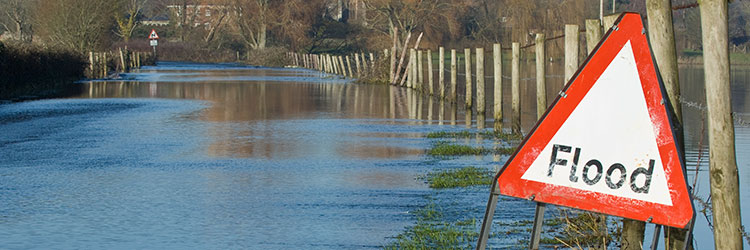
Although the damage caused by flooding can feel overwhelming, it’s important to remember that you don’t have to face it all alone.
The following suggestions are good starting points in getting some help after a flood.
Emergency advice
Floodline is a great source of information, offering advice and help in all stages of flooding no matter what time of day or night: 0345 988 1188
The Environment Agency also has a 24-hour incident hotline: 0800 80 70 60
Travel and accommodation
If you need to travel at any point after the flood, always check for further flood warnings in your area, as well as the latest updates on road travel.
If you need help regarding temporary accommodation, it’s best to contact your local council. The council should also be able to help you dispose of contaminated items, as well as arrange extra rubbish collections or a skip should you need it.
Reporting hazards
If the flood has resulted in a power cut or you need to report an electrical hazard, contact your local electricity company. If you don’t have Internet, try calling 105 for free.
To report a gas leak, contact National Grid to help you reach the right team.
Your local water company will be able to help if you have a sewage problem in your home.
It’s worth noting that you may need a permit to pump water out of a property. Check with the local Environment Agency office beforehand, as it may depend on whether you’re pumping water into rivers, ditches or street drains. Your local fire brigade may also be able to help you.
Reputable traders
Builders and other specialist traders will probably be needed. You should ideally use one that has been appointed by your insurance company or loss adjustor. But if you’re choosing a builder yourself, seek one from a specialist trade body, such as Federation of Master Builders.




